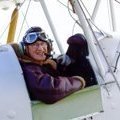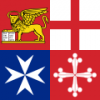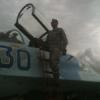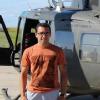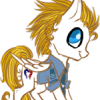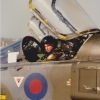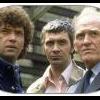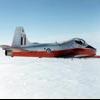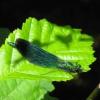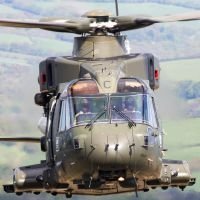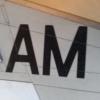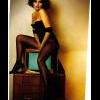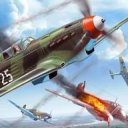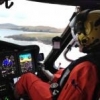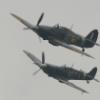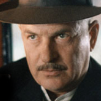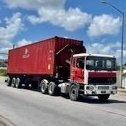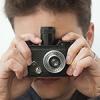Leaderboard
Popular Content
Showing content with the highest reputation on 05/01/15 in all areas
-
Hi all, I thought I would share photos of some of my older builds, all taken in natural light. This is done by using a Fuji camera and a base painted to look like concrete that measures approx. 3’x3’. I use the local airport as the back ground. In my opinion, there is nothing quite like the sun showing the work. When taking the photos, I try to envision the angles that I would be taking of real aircraft. scales are 72, 48, 35 and 32. Hope you enjoy the pics. NEW: got rid of photobucket.15 points
-
A Westland Lysander from Finnish Air Force, which I am a fan of. 1/48 Gavia kit, built several years ago with some photoetched parts, from Eduard if I am not mistaken. I thought that this plane was small, actually it is huge. It dwarfs a Spitfire if you put them close to each other... Probably the dihedral is too strong.15 points
-
I managed to complete my Christmas holiday Spitfire double build inside the two-week period I allocated to it! I started this build as distraction from a difficult kit I've been working on for over a year, and as such I wanted an easy kit. I made it a double build when I realized I couldn't pick which kit to do, and as I expected them to be pretty much shake'n bake. I was also quite interested to see which one would be my favourite. The Airfix kit is built as the early Mk.I that's included in the box, I just love the white/black wing scheme. This also allowed me to do a tiny bit of a conversion on the Tamiya and build it as a MkIIa, using the spares from the Airfix kit: Coffman starter, Rotol prop and fishtail exhausts. This MkIIa was the personal plane of Prince Bernhard of The Netherlands, husband to Crown Princess Juliana. When Holland was occupied by the Germans in May 1940, the royal family fled to Britain, where both Juliana and Bernhard, as well as Queen Wilhelmina, worked tirelessly to support the war effort against the Axis. Bernhard took a great interest in military matters and involved himself with soldiers and pilots that had fled to Britain as well, and he played a large part in creating the 322 (Dutch) squadron. He also had a reputation for being a playboy and he enjoyed driving sports cars and flying aeroplanes. As for my verdict on the kits: Very, very difficult to pick a favorite. The Tamiya has the best surface detail, the Airfix is (apparently) more accurate, Tamiya has slightly better fit, Airfix is considerably cheaper and in the series 2 boxing gives you lots of useful spares. Bottom line, it depends on what you value most. For me, the Tamiya's better surface detail puts it slightly ahead of the Airfix. Apologies for the quality of the pictures, there wasn't as much light as I really needed.14 points
-
My I first wish you all a Happy New Year This missed out on being the last one of 2014 but claims a respectful 1st for 2015. Its the new Airfix 1/48th Scale Gnat representing XP501 in the Summer of 1966. S&M decals to replace the incorrect colours on the Airfix ones and built out of the box. I can say this kit is a dream to build, The number has been added to the nose hgaer door since the photo's were taken! Thanks for looking Comments welcome as always Rick12 points
-
Hi fellow modellers! This is my first post here. For now, I only have pictures of my models finished, so it´s a kind of introduction for me. This is the old heller Su-27 UB. The kit has many fit problems, but overall is very accurate and represents well the shape and dimensions of the Flanker. I tried to make a faded look and I think the result was convincing. the only aftermarket were resin K-36 seats and metal pitot tube. I hope you like it, It was a fun build! Any commentaries and critics are welcomed!!! Best regards from Uruguay! Ignacio12 points
-
8 points
-
Here's my 1/72 Airfix Spitfire Mk.Ia (new mold) which originated from a starter set. OOB apart from Eduart pre painted harness, antenna from Tamiya Spitfire Mk.I & new antenna mount. I always scratch build the last part as the original part is lost in sanding. Kit is painted with Gunze Sanyo Mr colour Laquers thinned with hardware store universal thinner, they're really hardy paint + accurate in tone. Paints were faded with a little white for 'scale effect'. Decals are Aeromaster for insignia, Ventura black serial #'s & Modeldecal code letters. Sealed with Gunze clear coats. Panel wash done with india ink which I won't use again, to difficult to clean up. Exhaust stains done by spraying dark grey then scrubbing in Humbrol Smoke pigment & chalk pastels. Oil stains done using Humbrol Gloss Oil Stain wash <- This stuff is brilliant btw. I also see Airfix have used the same markings for their new mold 1/48 Spitfire Mk.I. Who wouldn't thought. http://www.airfix.com/catalog/product/view/id/8404/category/56/ Enjoy7 points
-
I picked up some Clear blue in Langleys in Norwich. So I've now got Tamiya clear red, clear green, clear blue and smoke thinned and ready to go. Must be able to sort out the tip tanks lights with that lot? I've painted a couple of test strips in clear red/clear green - and I'll practice applying blue and/or smoke over the top to see what I end up with, I had a very good Christmas/New Year as far as relaxing/socialising goes - but rather unproductive as far as modelling goes. I must say that it's been noticeable how much progress has been made on numerous BM builds during that time tho' - so at least I've been able to read about models (with one notable exception Bill (Perdu)- that said I see you've been sorting Ex-FAAWAFU's home brew decal needs ) I was going to mention my trip to Norfolk and revisiting my old home at Her Majesty's Prison Bure. But a moment's thought made me realise that this thread was in existence last Christmas and seeing as we went down to Coltishall then as well - I'd probably just be repeating myself......(again) In other news I have been trying to emulate Bill's (Navy Bird) skill at sticking protuberances onto 1/72 kits. Both there 3 and 5 had small black aerial blades on the underneath of the rear fuselage. Don't know what bit of avionics they were for. Easily formed from 1mm x 0.25mm strip. I scribed a suitable recess into the underside to give a positive location for the cyano (hint: it's the white scratch!): Which worked fine on both the 3 and the 5: Each jet has two yellow blade type (UHF?) aerials; one on the top one on the bottom. I had enough PE blades on the CMR frets for both JPs. I painted 'em on the frets and thankfully the attachment point was long enough to provide a lug for fixing: I followed Navy Bird's method of drilling a small location hole in the fuselage: And then putting a drop of cyano on the lug and popping it into the location hole: Worked a treat for all the aerials. Although I must admit that for peace of mind purposes - once the cyano had set hard - I popped a tiny drop of Krystal Klear either side of the bottom of the aerials at the fuselage junction - just to be safe..... Lastly for now I did the tail lights. Used the same method as on the chippie build. Drilled a hole and stuck in a length of stretched clear sprue (this is the JP5 tail): And then cut the sprue to length and gently rounded it with a fine sanding stick. I have a few more aerials to do (how could as simple a jet as a JP have so many bloomin aerials!!!!) I have to sort out the JP3 tip tank lights - and then I have to do the JP5 MDC and stick the canopies on. I think that's about all that's left They're now at the stage where I have to be really careful handling 'em cos of the various protuberances...... Shall have to think more seriously about the Hawks soon. The Hawk is a somewhat more popular aircraft than the Chipmunk/Jet Provost and there have been many excellent Hawk builds on the forums so I rather doubt that I'll be adding anything to the collective wisdom with my builds. Indeed I think my first task'll be to research what's gone before.........7 points
-
The unthinkable has happened! The model of the Beaufort is finished. And after all this time! Too late for photos tonight, but I shall set up the tripod tomorrow evening and make an RFI post. Then I can finally move on...to that stage where I sit staring at my stash with absolutely no clue of what to build next. It's the one part of the hobby that I don't like. If I only had one kit in the stash, this decision would be easy. But a man who has two watches never knows what time it is! Of course, I do have two partially built kits on the Shelf of Shame. I suppose a KUTA build would be in order. Cheers, Bill7 points
-
With the arrival of the Trumpeter Hornet(s) and the rather fine mess they've made of it I thought I'd start a new thread on ways to fix them (as far as possible) without too much stress. I've all ready contacted the Guru of all things Hornet, Dave Collins and invited his input into this thread. Also I know Jon K.T is keen to do a build and at least he will paint his. Where possible I hope as we do this, I will be able to produce some correction parts in either injected plastic or other mediums. Behind the scenes David has supplied me with a further range of dimensions and co-ordinates with which to check my drawings which in turn have been done from my assembled DH data and so far I'm singing from the same hymn sheet as David who has so much more, as well as a complete Hornet cockpit.. What I propose are workable fixes and start with what is wrong with the kit. Some discussion has already been started in other threads such as the one on the HpH kits and one in the WW II thread but i thought that it was much better under one banner. I welcome any helpful input or questions. I will say again, that it would be wise to ignore any of the previously published drawings of the DH Hornet from whatever source as they are without exception badly flawed. This codicil does not include the unpublished Arthur Bentley drawings which Iain has. John These are just to show something of the background work that has already been done. The above drawings are early sheets of my still unfinished drawings but later printouts will suffice for this exercise.6 points
-
Airfix 1/72nd MKI Avro Lancaster G-George. From the 1978 2nd tooling version on black sprues. Please note, I did not build the model, it was made for me by Ian Collis. So we didn't want it to resemble G-George as can be seen in the Australian War Memorial (AWM) museum today, but instead went for the look of the B/W photo of it when in service. So the bomb run on the nose, was copied over to the model. Now this old Airfix kit is supposed to be of a MKI but infact to make it so needs some Mods. First the bomb aimer's blister for MKI's had a shallow nose blister, all late and MKIII Lancasters have the larger nose blister, as does what came in the kit, so it was changed. Next G-George has small windows in it's fuselarge body, this old kit does not, again these had to be cut in. Other Mods and upgrades were to add Blind pole approach (on the fuselarge) - Balance weights (on fins) - aileron linkage arms (on main wings) - balance weights (on rear wings) - Early antenna (on cockpit)) - resin machine gun barrels and the breaches added where missing - resin wheels - 1,000lb bombs - Photo Etched seat belts and a little scratch work in the cockpit. Finished with a whiteish exhaust staining and weathered. Over the years Ian has built most of the Lancaster kits out there and he still rates the old 1/72 Airfix kit as one of the best. Sorry but there's rather alot of pics to follow 20141215_095908 by triumphspeedtriple1050, on Flickr 20141215_095839 by triumphspeedtriple1050, on Flickr 20141215_095807 by triumphspeedtriple1050, on Flickr IMG_102232749503167 by triumphspeedtriple1050, on Flickr 16148182641_f75ca9b2b5_o by triumphspeedtriple1050, on Flickr DSCF0069 by triumphspeedtriple1050, on Flickr DSCF0086 by triumphspeedtriple1050, on Flickr DSCF0086 by triumphspeedtriple1050, on Flickr 15964227677_8171044da1_o by triumphspeedtriple1050, on Flickr grass2 by triumphspeedtriple1050, on Flickr grass1 by triumphspeedtriple1050, on Flickr grass6 by triumphspeedtriple1050, on Flickr grass5 by triumphspeedtriple1050, on Flickr grass3 by triumphspeedtriple1050, on Flickr DSCF0019 by triumphspeedtriple1050, on Flickr6 points
-
I've played about with the kit canopy and as it's too tall and misshapen, I pared and filed off parts of the lower edges and reduced the top curve, as you can see here. The cut down canopy on the left can now either be polished back and used on the model, but mine will be used for a new Vacform replacement once the correct framing is done. The max depth of the canopy should be 10.5 mm. The next step was to test fit the modified canopy onto the modified fuselage, but first I razor sawed the fuselage top behind the canopy of the main fuselage. When the canopy is moved to the new location a gap of some 4 mm is left behind, by cutting this piece off and moving it forwards, it will match the canopy 'pen nib' and thus leaving an easy filling job, using scrap plastic and milliput. I used a similar piece off another kit. The next step is to refine the windscreen side panels and put in the gentle curve along the lower edge of the side screens and blend it in with filler. Note the front edge of the wing box is the Trumpeter wing Datum. The true Datum is 2.5 mm in front of this I have used the True Datum to locate things with my drawings. However for your convenience, the lower rear edge of the modified kit canopy is 2.5 mm behind the Trumpeter Datum. and the front edge of the sliding hood is 18 mm forwards of the Trumpeter Datum. Now the rear edge lower corner of the canopy should be 2 mm forward to be true, but if you do that then you will have to match up the front edge of the fuselage.6 points
-
Well here's my first completed model of the year. The kit certainly doesn't fall together, and if you're tackling one straight after an Airfix one, you'll be in for a bit more work to get things to fit. That being said, you do get some brass and resin to play with, and the decal sheet is very well printed, even if the instructions are rather vague on their placement, and once again the classic "keep clean of intakes" stencils... Anyway, Alclad finish once again, though this time it's a bit cleaner than my previous Lightnings which morphed into dirty birds in their construction! The pilot figure was painted in suitable 60's attire, and I decided to leave the missiles off as they are not a strong point in any Sword Lightning. And here it is in my little collection.. Just got the F3 and T5 to do now5 points
-
For anyone interested in WW2 airpower and particularly the Luftwaffe I wouldn't describe it as obscure It's not every day that a supposedly beaten foe can launch an operation on this scale, however futile it turned out to be. The Luftwaffe managed to destroy 143 single engine allied aircraft and damage a further 139. For twins these figures were 74 and 12, four engine aircraft 15 and 5, giving a total of 232 destroyed and 156 damaged. Losing nearly 400 aircraft on one morning wouldn't have seemed 'obscure' to the Allied air forces sustaining the losses! The futility lies in the Allies ability to simply replace these aircraft from air parks in the UK, often within a couple of days. The Luftwaffe lost 271 Bf 109s/Fw 190s destroyed and 65 damaged, and several Ju 88s serving as path finders (Lotse), a trade it could make. The real problem was the loss of 143 pilots killed, 70 taken PoW and 21 wounded. These were irreplaceable, particularly 22 unit commanders comprising 3 Kommodore, 5 Kommandeure and 14 Stafelkapitane. Many of the others lost, around 145, had less than ten operational missions, several were flying their first. A day on which well over 700 aircraft were destroyed or damaged on both sides makes even the heaviest days' losses in the Battle of Britain look like skirmishes It was the last throw of the dice for a once mighty air force. Obscure? Depends what you are interested in Cheers Steve5 points
-
Well having failed to complete my Bomber Command GB Lancaster within the deadline I now give myself the challenge of 2 builds in one GB!! First cock-up: I've realised that my cunning plan of doing 2 x 1/48th builds has been undermined already - that'll teach me to concentrate when ordering. Anyway here we go with the first build: a 1/72nd Su-30 of the Ugandan Air Force made from the Trumpeter kit The Kit: The Contents (well some of them): The Decals: And this is what I am aiming for (copyright:Tarmac Images):4 points
-
Dear Fellow Modellers These peculiar shaped IJN Destroyers were inspired by German WW1 designs. The gun armament was placed above the main deck to ensure all armament would function in heavy weather. The strange focsle reminds me of a whaler? This old kit had no portholes or details on the deck houses so I embarked on a month of scratch building and photo etch extravaganza! I think Mikazuki means 'full moon' Hope you like it? Andrew4 points
-
Hello friends Happy new year for all of you This was the lat build from 2014 the Zvezda 1/35 kit with some scratch. I hope you like it Best regards from Portugal Vitor Costa4 points
-
Morning all, Just wrapped up the Spitfire, the first of my Battle of Britain builds. Had a lot of fun knocking this one together For those interested, the WIP thread can be found here: http://www.britmodeller.com/forums/index.php?/topic/234972713-172-airfix-baby-spit/ Without masks for my Do17 and a gun pack for my Blenheim, I might move onto something different until I've all I need to start the next BoB build Thanks for looking, comments welcomed Cheers Shaun4 points
-
The plan is to do one of these two babys. Found on Nils 'Vingtor' website http://vingtor.net/profiles_content.html The only teeny tiny snag is that I am unable to find any other views or photos of either....yet! Won't slow the build anyway tho. 😀4 points
-
Ignorant (from my dictionary) : Lacking knowledge; having no understanding or awareness. As far as I'm concerned, admitting ignorance of a subject carries no disgrace (I am ignorant of German aircraft, calculus, the theory of relativity, nuclear physics, and many other subjects.) I've spent many hours, finding out that, from Autumn 1942, Supermarine, Hawker & Bristol spent time on filling rivet holes and panel lines, sanding them smooth and then painting them, making the chances of there being black lines under the paint non-existent. If someone asks about pre-shading, I start with the premise that they might not know that fact, possibly pretentious, but it saves a lot of time; I do not say that they shouldn't weather on top of the finish, which is how I always preferred to do my own models. After several house moves, I have no models left. "Wonderful finish" "Superb model" when the model has glaring errors does the modeller no favours, in fact it's downright insulting, and, if that means that I should not pass on information about the real item, which I feel might be beneficial to others, then I want no part of it. Not sadness, aggravation, since you fail to grasp that, to me, how others finish their models is irrelevant, but if "positivity" means asking for my approval for using techniques completely at variance with what really happened, forget it, I'm old enough to remember how this pre-shading malarkey started; an American modeller first used (only) gloss varnish on panel lines, and a piece of cloth to buff over the paint, so that there was a beautifully subtle (and extremely faint) variation in tone and nothing more. We always went by the simple maxim, "if you see the weathering before the model, it's too heavy," but that now seems to have been discarded.4 points
-
Crew painting time, not sure about these so far? 1-1 ref pictures, I found my old Crew cover in the garage so I'm going to use it as ref pictures, This old lid of mine has done a fair few miles. onto the figures, The 35th scale version, faces are masked up with bluetac. I wanted to give the coveralls a washed out look, so some slight variation in colours between the crew members. Not convinced yet that they look right, so I might strip and start again, I've only added some basic shadows into the creases but they are just not doing it for me TBH? Beginning to think that black coveralls would of been easier ! Regards Dan4 points
-
The Trumpeter Hornet F.1 sadly follows the (sods) law that "models and drawings of the most aesthetic aeroplanes, will be inversely proportional interpretations of the real thing" as in the case of Spitfires, Hunters and the Hornet. Is this kit savable? IMO yes, but there is precious little to to start with. Are we going to end up with a perfect representation? Nope! In this case I think the object should be to to make something that looks like a decent Hornet model and how far you take this will depend on your own skills. All the following measurements and calculations are based on my work which is grounded on original De Havilland and RAF material and should I be in error then I'm sure David will help to get the right answer. So what's right about the kit... The wheel hubs are very nice and the spinners are pretty good. OK let's move on. What's wrong with it... well I'm afraid that this is going to be about as long as The Book of Lamentations. Taking sections at a time let's start with the fuselage. Apart from the nose and cockpit areas, it is in profile generally acceptable. It is too wide by around 1 mm and too short (for a Mk.1) from the nose tip to the base of the tail light by about 2.5 mm. I haven't started from the kit Main spar datum as I find this is is again about 2 mm to far aft. Bear with me and my reasoning will become clearer. The cockpit sill height is pretty good, which in turn shows that the whole top of the nose is too high and humped. The cockpit is too far back. The canopy it's self is too tall and the lower edge of the windscreen side panel is canted up at the front, it's also too short at the 'pen nib'. If we can fix the grotesque upper nose area then we can cure the main visual problems to the front fuselage. The problem... As you can see by the rough sketch above I've outlined the areas to be altered. Using the cockpit sill as a guide, with a razor saw cut forwards along the blue line to remove the Red shaded top of the nose. I then cut the unshaded portion of this piece off, and cemented this back as below. When the modified canopy is in place some improvement of the nose contours can take place. Next the canopy. .4 points
-
I do most humbly apologise; I did not realise that, having reached an age when I feel my hand skills are no longer good enough, it also precludes me from having an opinion and trying to help a questioner. Perhaps you would care to show any occasion when I've said that a modeller shouldn't do what he likes with his own kit? Funny, really, since I always strove to get photos of real aircraft, and make my models look as much like them as possible, which is why I supplied that horrifyingly negative photo of a real aircraft.4 points
-
Great builds. Great Fun. Thanks to Col, Enzo and Mish for getting this off the ground. EE Lightning II anybody???4 points
-
A hobbies a hobby and people will spend what they can afford. Think of it this way, if your hobby is fishing, reels can costs thousands. If you enjoy playing the guitar, they can be equally expensive. I'm sure if they were able to get something that isn't ordinarily available for £40 a month over two years they would jump at it. Just because modeling is a niche hobby does not mean that companies such as deagostini are fraudsters and deserve to go out of business and that I, as the consumer are "stupid" for subscribing to them.4 points
-
My second model today. This conversion from Tamiya for modification D-5. I used a lot of extra sets. They appear in the picture. Also, I removed the extra joints of panels on the wing. Decal from Kits World.3 points
-
Right at the top, I'll acknowledge that Blackburn afficionadoes will recognise this drawing as a straight copy of a frequently-reproduced Blackburn photo; it was done as a practice piece just to keep my hand in, so I claim no originality whatsoever! G-EBKF was a dual-control floatplane adaptation of the service Blackburn Dart and was used by The Blackburn Flying School, situated alongside the Blackburn factory at Brough on the river Humber, as an advanced seaplane trainer. The floats incorporated 'fold-up' wheels to facilitate ground/ramp handling. There is an interesting period article on the aircraft here: http://www.flightglobal.com/pdfarchive/view/1925/1925%20-%200271.html Most of the original Blackburn factory buildings at Brough are still extant, although they have unsurprisingly been altered and incorporated into the modern BAe Systems facility. The site of the original slipway into the river is also still apparent, but only just, and the slipway itself is long gone. Comments and criticisms welcomed. Jon3 points
-
So my second entry (I hope) into the LBAFGB will be a Kenyan Air Force F-5E in 1/48th. Wish me luck!! We shall start with the obligatory shots. The Kit: The Contents: The cockpit detail set; God knows why I bought this as the kit cockpit looks pretty good as it comes!! And the Decals: Decals for this build have been something of an issue as no-one seems to be able to produce the KenAF decal correctly. Note the erroneous matching width of the black, white, red and green bands on the Roundels of the Wirkd set and a missing white band in the International Hawker Hunters set despite it being shown correctly on the instructions: Still, I do have access to some custom made decals so hopefully some of these will suffice! And this is what I will be aiming to build:3 points
-
I built this a few years ago. Tamiya 1/48th F84G Thunderjet. Eagle strike decal set number 48143 The aircraft was a F84G of the 310th fighter bomber squadron, 58th fighter bomber wing, Korea 1952. I painted the model with various shades of Alclad 11 & Aeromaster acrylics The Tow tractor is a Clark CT46 from KMC. Thank you for looking.3 points
-
I had no idea where to put it so it's here Last year (it was october, I think)) I bought a dragon figure in souvenir shop in Cracow. It was wonderful, different than all these quasi-dragon figures. It was green with big "K" letter as a Cracow emblem. I've decided to repaint it to resemble Ice Dragon and remove this awful letter. I've used mainly airbrush and drybrush, only eyes, claws and teeth were brush-painted. The result below. Hope you'll like it3 points
-
3 points
-
Good evening, to do something a bit different, I chose to build this little fellow as part of a Phantom group build on a german modeling forum. It's the very old Hasegawa Phantom Eggplane. It comes along with a small "spook" figure, and has two painting schemes. One is a USAF SEA scheme, and a gull grey JSDAF, which I built. The kit goes together rather well, almost no filler needed, and has even two decal sheets (looks like the second is an "update"). I just added the ejection seat firing handle. And - it's the hasegawa phantom kit with the most ordnance included! Thanks for attention! Alex3 points
-
Hi, Lot of the time has been spent on some strange activities and due to some reasons I was forced to change the priorities in my hobby. Anyway - the time has come and I can start the paintwork. Last pics before painting. The only upgrade is the resin Rotol from Department of Correction which is originally designed to Tamiya's kit. So has better fitting then Hasegawa's one. And here are mentioned above some reasons of delay.3 points
-
And then there were two. Thats taken me ages to do and my eyes dont thank me for it. Still a couple of adjustments and fixes to do along with the dry brush, but thats enough for me for one day. Also sanded one of the inlets and got the best fit I could, got the other side to do, glue em both on and then its filler time for the plane itself I think. Woo.3 points
-
Ready for Inspection - completed model of the Junkers Ju87 - B2 completed at the end of December 2014 The kit was the Italeri 1/48 scale. Very nice kit with some good detail. The build is straight from the box with no additional aftermarket items. Paints were mostly Humbrol - using their newish RLM range.3 points
-
I`ve just read the entire thread from the start and it is another classic Neil,....to add to the Halifax, Stirling, Whitley and others! You should contact somebody like Gary Hatcher at SAM Publications to see if they are interested in putting them all together in print, just like the book which was done on Luftwaffe modelling. They did a book about modelling RAF Bombers but yours could be aimed at the next level up as a Bomber Command Master Class,...it would be a great source of reference! Keep up the brilliant work mate,.....you are doing a great job, Tony PS- Are you still struggling for decals or are you fixed up? Drop me a PM if you are stuck on anything as I may be able to help?3 points
-
For a moment there I thought you'd finally seen the light and started fitting an arrestor hook... (Mind you, not sure I'd want to try to stick a JP on a carrier; from my very limited experience of the aircraft I don't recall the acceleration being too startling). I ran out of superlatives long ago, but you know we all think they are both superb!3 points
-
I wasn't sure how much extra of the flight deck would be viewable via the entry door but decided to superdetail it anyway. The first thing to note was that fitting the vestibule showed up the fact that the flight deck floor as supplied in the kit (part no. 3) sits way too high, the real thing being level with the vestibule floor with no 'step' between the 2. I therefore retained this part (along with the front bulkhead, part no. 8) for a future build of an HS125 CC1A and scratched up a new floor and bulkhead out of 20thou Plastikard using the kit parts as templates. Detailing was done as per the first Dominie build but with the addition of the LP Cocks, Fuel X-Feed/Transfer Lever, and Pressurisation Override Lever to the aft face of the central pedestal, as well as an alteration in the instrument panel layout as per the changes to the real aircraft. Now a trial fit of the vestibule into the port fuselage half. Here you can see the detail on the front face of the flight deck bulkhead as well as the fold down supernumerary seat made from Microstrip (yet to be painted). The flight deck and vestibule sub-assemblies could now be test fitted.3 points
-
This model is of zero interest to me, but I agree with the above. If it were a part-work of a Ferrari 250 GTO, I'd part with the £9.00 a week like a shot. Yet many 'moaners' will 'splash' their money up the pub loo wall, or stink ordinary mortals out with smoke, and have nothing but a headache and an empty wallet to show for it. How much is a season ticket for Footie? - the most brainless activity ever invented. Also as said above, each to their own. I have no doubt there are a few here who think I'm nuts for being a Pocher fan...... Roy.3 points
-
The model sucks, I know. I couldn't do any better with that old 1/48 Airfix kit. But, man, I do love the Hawker Fury. I find it really elegant. You can see in those lines what will have become the Hurricane. This one is actually a Hawker Spanish Fury as it was dubbed. Part of a small lot built for Spain that took part in the Civil War in the Republican side. Landing gear in the Spanish ones was slightly different from the British versions. I used a old spare part belonging to a Gladiator....3 points
-
Significance is something else. For the Allies Bodenplatte wasn't particularly significant because their materiel losses could easily be replaced and their personnel losses were minimal. They knew they were winning the war. Nonetheless, I'm sure it was a nasty shock! It was significant for the Luftwaffe for the reasons above. It also followed very heavy Luftwaffe losses in the weeks preceding the operation in an understandably better known affair "Wacht am Rhein", Battle of the Bulge. There's nothing like a Hollywood movie "Bodenplatte" really was a last gasp. I was surprised to see one of the major air offensives of the war described as obscure. This is not a criticism of the poster or the comment, it really does depend on what you are interested in Cheers Steve3 points
-
May I add a comment ? Part of the work done with pre/post-shading and washes is not related to reproduce weathering but to make the completed model more "3-dimensional". This means that the modeller may apply things that don't exist in reality but have a certain effect on the final product. For example I sometime like to darken a bit the areas where the wing meets the fuselage on a low wing aircraft. At the same time, I usually keep other areas of the wing slightly lighter and the same for the top fuselage. In a real aircraft all these parts are (in theory) of the same exact colour, however on a model this technique simulates shadows and highlights that I would see when looking at that real aircrafts. The light will never create the same effects on a model, hence the use of artistic license to simulate this. I know I have introduced some non existing features, the end result is however more realistic to my eye. The same applies to many other techniques, on which I'm sure we'll never find an agreement...3 points
-
I'm actually surprised by how much I like her in grey - for my money, the F.2As in green are the bomb, followed closely by anything in nat metal (the 2 colour upper camo is hideous, IMO), but the grey has grown on me. And for an old kit, they do indeed scrub up well - I'm considering finding another and throwing all the resin and etch at it that I can find, plus some rescribing, just to see what can be done. However, I think that Airfix may have made Hasegawa's version irrelevant, and I do have one each of the Airfix kits (so far... although I do also have a pair of the 48th F.2A/F.6 kits and no less than 4 of the other version. My name is Rob and I have an addiction. ) Never mind, worse thing happen at sea, as my old Grandad used to say (He was RNVR during the war.) I'm going to let my Lightning sit for a few days to allow the paint to cure properly (and because I'm back out to work on Wednesday), then I'm going to do some judicious sanding and repairs, to pretty it up a bit. Then it'll be getting finished before I start another GB, I think. For the Lesser etc GB, I have a selection of Latvian marked a/c to choose from (late WW1 and between the wars types), and I'm also doing a Super Tucano from Mauritania, if the Big H ever get the decals back in stock; that's what happens when you hesitate. However I have decided that in between doing new stuff for GBs, I will be working on reducing the large quantity of half built kits on the shelf, so before I start the LBAFGB, I'm going to finish off my Trumpeter F-107A - unconventional single seat fighter, somewhat like the Lightning. It's mostly there, just needs paint and dangly bits adding, so it will be a quick study. I hope. Shame indeed, but I had fun. Thank you to all who looked over my shoulder and commented, I appreciate the support! This one will be finished soon, hopefully over the coming weekend.3 points
-
Hi everyone Epic failure I'm afraid, left it too late to start and then too much to do at the end, finally realised it wasn't going to happen when I superglued my fingers to the front wheel of the undercarriage, net result broken front suspension and a few layers of skin less. The masking wasn't the best either, the canopy looks like I've done it by hand and then finally as if I hadn't got the message, I tried to apply the cockpit instruments decal, only for it to slip down under the pilot never to be seen again ! So enoughs enough, photos of current shambles below, I will finish it so it doesn't join the shelf of doom, but not tonight.... Cheers Pat Congratulations to all those that finished3 points
-
The flight deck bulkhead could now be detailed. The flight deck side of the bulkhead was detailed as per the previous Dominie build because it didn't alter between pre- and post-DAU aircraft. This shot explains what's what on the vestibule side of the bulkhead – yet to be added is the fold down supernumerary seat on the port side of the flight deck access portal.3 points
-
And who is forcing you to buy it? I know alot of people who have the same reaction to £30 for a box of plastic bits3 points
-
Horrifying negativity here! If someone enjoys a particular finishing style, and painting like that makes them happy, I won't be ranting about why I find it wrong, infuriating or hilarious, I would feel rude doing that. Would Edgar and Graham be kind enough show examples they think do look good? Maybe some of your own builds? I think jimmydel's Ju-88 looks great- the photographic lighting is might be exaggerating the specularity of the finish, but is still looks very nice indeed: what scale is it? As I am so modest(!), I will post my own work to me laughed at/told it looks wrong/like a toy (which 99% of the population would think any plastic aeroplane is): (1/48 Hasgawa) WIP thread RFI thread3 points
-
Yes, indeed, a lot of variation. I learned one thing from studying the photos. In many cases the war time censors have removed the under-wing antennae - you can sometimes still see traces of it or the supports. Quite a few of the photos that show the fuselage aerials but not the under-wing antennae have been censored. But there are still quite a few that are exactly like you say. Good luck on your build! The kit goes together quite well, and there are some schemes that don't require all the photoetch. One comment you hear quite often is that the canopy is too wide - I found this to be true. A thin shim in-between the fuselage halves will make the fuselage wider, so the canopy will fit well. It's a lot easier doing it that way than it is trying o make the canopy narrower. Thanks! Oh, I've had some paint come off of the PE. I just touch it up with a really tiny brush. OK, let's look at some more pictures. Special Hobby provide a resin gun for the turret, which is fair facsimile of dual Brownings. My understanding is that the later Aussie Beauforts had these guns in the turret, replacing the Vickers gun. Brengun provide some PE ammo belts, so I added these to the guns hoping that you'll be able to see them through the turret. I left the pieces long, planning on trimming them later. You'll notice that Brengun also provided a flat PE piece with the oval hole in it - I'm guessing this protected the gunner, and allowed him to see through to the sight at the end of the gun barrels. I mounted the gun into the turret, and found that I had to trim off all of the ammo belt that was lower than the bottom edge of the turret, otherwise there was interference. The turret ended up looking like this: The turret was then glued to the fuselage. You should be able to see the gunsight that I raided from the Magic Box of Fiddly Bits - it's at the end of the gun barrels. I have photos that show this kind of arrangement, and others that show a different one. The large aerial mast was also added - and it is an ugly aerial mast indeed! I think that it really takes away from the appearance of the bomber. You'll also notice that I've added the D/F antenna in its deployed position. If you're really astute, you'll see that I've done it wrong! What a sod! I'll fix it later. While we're on the top of the fuselage, let's add the aerial wire. As always, I use 0.005" diameter Nitinol wire. The wire's natural state is straight, so you just have to cut to length and glue it on. Now you can see why I need to change the D/F antenna - it's too high. We're nearing the end. What's left? Right, the hole in the roof illusion. You may recall that several Aussie Beauforts had an upward firing gun that protruded out of the top of the fuselage near the main access door. Surrounding the gun itself there were several small windows and the entire framework sat proud of the surface. My plan is to replicate this without having to cut a hole into the fuselage. So first, we cut a piece of thin clear plastic to the proper size. Thanks to Fred and Ed for supplying copies of the drawing and a template that I scaled to 1:72. I rolled this against a large dowel in order to put some curvature into it. I then painted the inside Gunze H95 Smoke Gray. I let that dry overnight, and then masked the windows and painted Foliage Green (Gunze H302) on the framework. Finally, I added a decal of a black circle which came from a 1:48 scale ESCI Alpha Jet kit. I don't have this kit, I don't remember ever having or building this kit, but for some reason I have the decal sheet. Odd. Although the windows look black in this photo, when you catch the angle just right you get a nice reflection off of the surface of the windows. That's the illusion that makes it look like it's actually a window. I think it works well - if I had cut a hole in the fuselage you wouldn't be able to see much inside anyway. All right then, I think all I need now is a gun barrel to point out of this window, and that should do it. Stay tuned! Cheers, Bill PS. Oh yeah, I suppose the props need to go on, too.3 points
-
Lightning F.1A XM194/A, 111 Squadron, RAF Wattisham, 1963 Kit: Airfix 1/72 Lightning F.2A Aftermarket: Alley Cat Lightning F1/3 conversion set. Decals: Xtradecal 72088 Build thread: http://www.britmodeller.com/forums/index.php?/topic/234968481-stripy-lightning/3 points
-
Thanks very much for the encouraging words gentlemen! I certainly appreciate them. Sorry about the headache Chris...I had one or two doing those underdeck supports as well. Anyway here's all the underdeck supports, trams and columns done: Now, where does all that pe go anyway? The flight deck is divided into 3 parts, but in looking I saw the underneath of all of them was pocked with large ejector marks and many unwanted ridges. As I wanted a flat base for the grids to attach to, that had to be fixed. Mr. Surfacer, to do the fills, and some sanding got me what I needed: After painting the underside of the deck parts, I laid out the pe supports on the deck to check the fit I was especially worried about this part because of the changes in the elevation of this part of the deck (the deck that this part covers is at first flat, then slopes down about 1/2 inch, and then flattens out again...but it was a perfect fit. Kudo's to the guys who designed this pe! Mid-deck parts checked for fit: And another overall shot: Thanks for viewing my model ship build so far, comments are always welcome of course! -Tim3 points
This leaderboard is set to London/GMT+01:00

